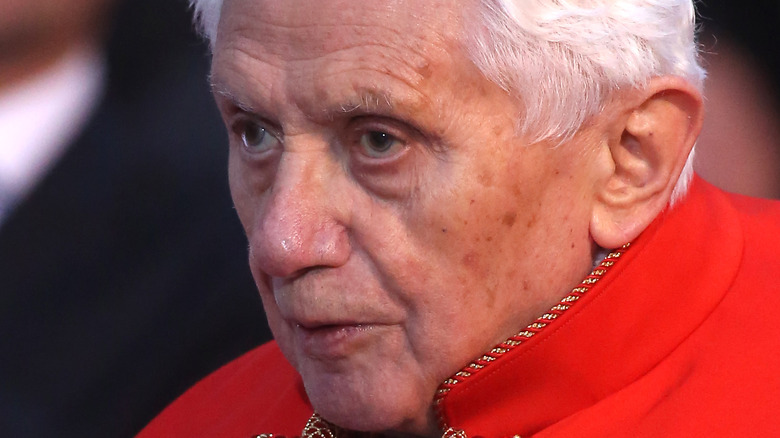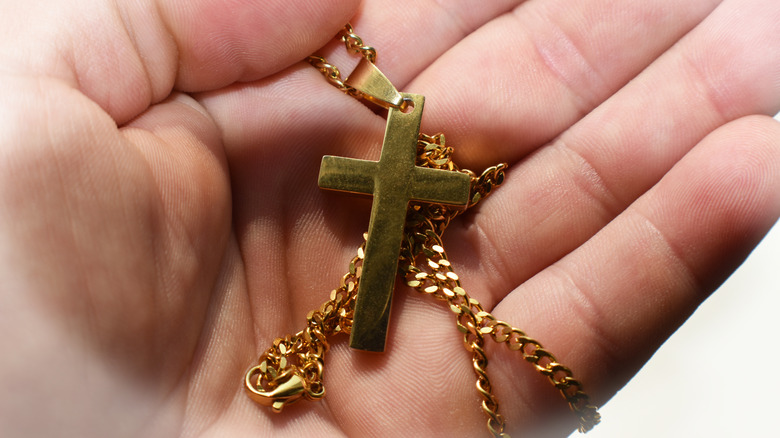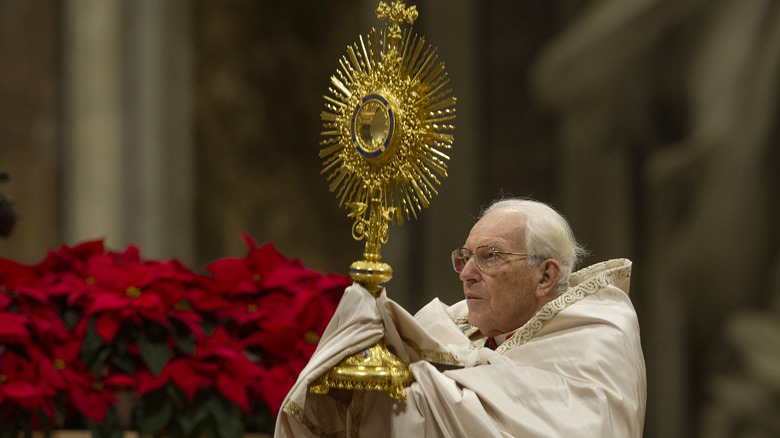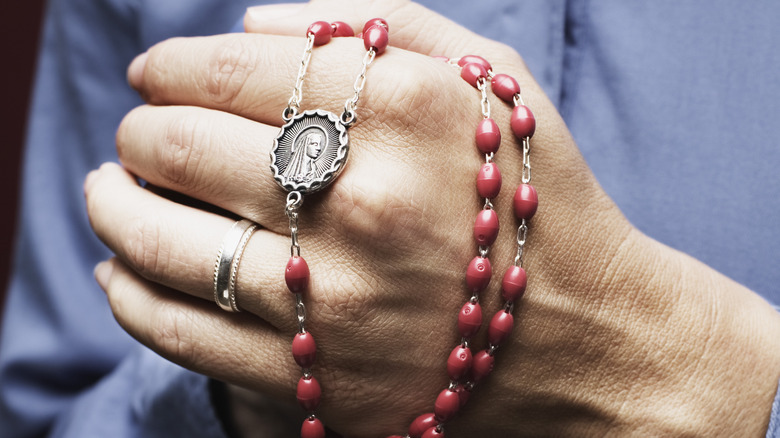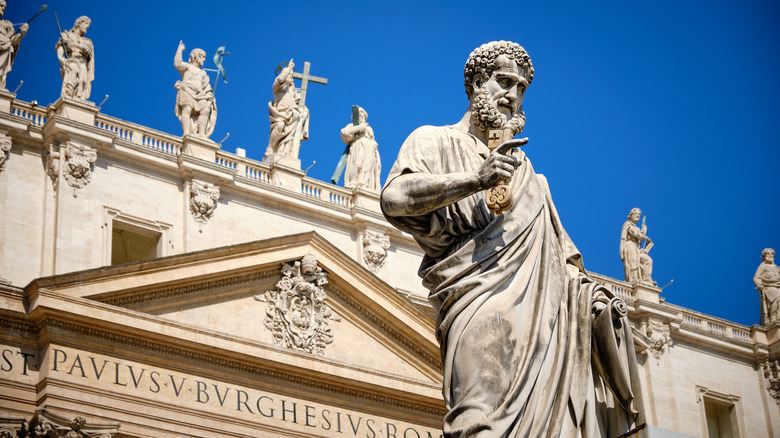The Confusing History Of Popes Named Benedict
On December 28, 2022, as BBC News reports, Pope Francis I announced that his predecessor, the still-living Pope Emeritus Benedict XVI (above), is "very ill." Following an address to the faithful — his final of the year — the pontiff asked his flock to "pray a special prayer for Pope Emeritus Benedict."
Benedict XVI holds the title of Pope Emeritus because he is one of only a handful of popes to step down from the position while still living (the job of pope is for life) after having only served eight years (via Smithsonian). Benedict was 85 in 2013 when he stepped down, at the time citing his advanced age; he is now 95.
In fact, there's more to the story of Benedict's title than just the "emeritus" appellation. Though he was born Joseph Ratzinger, he did as dozens of other popes before him did and took on a papal name. And though logic and reason would suggest that he was the 16th man to serve as pope using the name Benedict, a complicated aspect of the history of the papacy and the Catholic Church has made things a bit ambiguous.
The First Pope Benedict
All the way back in 575, a man whose birth name is unclear assumed the job of pope and began his papal reign as Benedict (via Britannica); according to the Online Etymology Dictionary, "Benedict" comes from a Latin word that means "blessed." He served for a few years and did the things that popes do or did at the time, such as promoting other clerics to high positions and being involved in land dealings. His papacy was marked by difficult times in Rome, including an invasion as well as a plague and famine. He died in 579 during a siege of Rome.
A century later, according to Britannica, another man would assume the job of pope and take the name Benedict (he later became a saint). History has given him the name Benedict II, because that's how history records the names of rulers who share the same name as a predecessor (popes are rulers, at least figuratively). Considering that the most recent pope to use the name Benedict was Benedict XVI, it would stand to reason that he was the 16th pope of that name. And that would be true, but one got posthumously demoted, making the math a bit fuzzy.
How The Pope Gets Elected
Since it will come up later in this narrative, now is as good a time as any to explain how new popes are chosen. As BBC News explains, when the sitting pope dies, all of the Catholic Church's cardinals — the highest rank in the church below pope — are summoned to Rome for a conclave. Put simply, a conclave is a sort of conference during which the cardinals talk things over and hold ballots until a new pope gets a majority of votes. The new pope is then announced to the world.
However, centuries earlier, things were quite different, and the process to select the pope was considerably more open to interpretation. We're leaving out enough historical and religious nuance here that libraries could be built containing what's left out, but (very) long story (very) short, ruling aristocrats wanted in on that action, too, and the matter of who was pope could often be simply a matter of whose guy had the bigger army (per Encyclopedia.com). The papacy of Benedict X was one of the factors that led to the revisions in how the pope was elected.
Benedict X and the Antipopes
Officially, the list of popes is very long (via New Advent). Dogmatically, the Catholic Church believes that Peter was the first pope, followed by Linus, and going on in an unbroken line through the current pope, Francis I (this is called Apostolic Succession). However, the official list contains the names of several other men who, at one time or another, pressed their own claim that they were indeed the pope and not that other guy (or guys). History has called these men "antipopes," and as EWTN explains, an antipope is "a person claiming to be pope who was not duly elected or proclaimed while a duly elected Pope was still in office," and there have probably been 30-40 such men over the centuries. In fact, for around a quarter of a century, there was even an antipapacy of a sort; as Britannica explains, between 1378-1417, there was a succession of men who claimed to be pope while simultaneously the Catholic Church insisted that they were not the pope.
Benedict X wasn't the first antipope, nor would he be the last, but he was definitely Exhibit A.
Giovanni Mincio (Benedict X)
Benedict X's papacy, or antipapacy if you will, was brief and unremarkable. According to Britannica, he only served for a few months from April 1058 to January 1059. However, it was the events that happened before and after his reign that made it a turning point in Catholic history.
Giovanni Mincio got the job of pope thanks to the backing of a powerful Roman family and, according to Debra Booton McCoy of Catholic 365, was actually a good choice for the job. "He was seen as good, wise, humble, and chaste, an excellent choice in a pope," she noted. What happened next is complicated, but long story short, the Bishop of Ostia was not best pleased and refused to consecrate him. "Thus Benedict was irregularly elected and irregularly consecrated," notes Encyclopedia.com. Also not best pleased were all but one of the church's cardinals at the time, who fled Rome and deposed Mincio. Mincio, after his deposition, was tried and, in an act of mercy by the then-Pope Gregory VII, was allowed to live out his days in a hospice. Gregory considered Benedict X a true pope and allowed him to be buried with honors.
Demotion And Fuzzy Math
The Benedictine debacle of 1058-1059 set into motion a series of events that governs the internal workings of the Vatican to this day. As Catholic 365 notes, the man who succeeded Benedict, Nicholas II, changed the rules — after him, only cardinals could elect the pope. That rule remains in place to this day.
For a couple of centuries, there was no ambiguity about Benedict X's papacy. However, in the 13th century, Pope Honorius III demoted Benedict X to antipope, and to this day, he remains off of the official list of popes. Unfortunately, when he was struck from the list, that didn't mean that the next pope to take the name Benedict would take the now-available (again) Benedict X; rather, he took the name Benedict XI, followed by Benedict XII, and so on. By the time Joseph Ratzinger took the name Benedict XVI, 16 men had served as pope with the name Benedict; however, only 15 of them were truly popes — at least, dogmatically. That means that Benedict XVI was actually the 15th (real) Pope Benedict. Should the next pope, after Francis I, decide to take the name Benedict, he would be the 16th official Pope Benedict but would take the name Benedict XVII, as if he were the 17th. Because history is rarely, if ever, straightforward and unambiguous.
